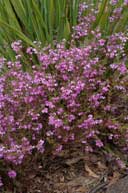In Flower This Week
A news sheet prepared by a Gardens' volunteer.
Numbers before each plant refer to temporary IFTW labels in the gardens.
Numbers in square brackets [ ] refer to garden bed Sections. Plants in flower are in bold type.
View past issues of 'In Flower This Week'.
1 October 2014
Tetratheca pilosa subsp. latifolia click for larger image |
The Gardens are full of spring flowers at this time. Today we stay close to the Visitor Information Centre (VIC) to see many endangered species and a few more common plants.
- As you leave the VIC head for the steps down to your right. On the corner on your right is Zieria prostrata [Section 221], a multi-stemmed, prostrate, mat-forming shrub with pink star flowers in profusion. This species has a very restricted distribution near Coffs Harbour in north-eastern New South Wales. It is known only from four headlands and is listed as endangered in the wild.
- Prostanthera stricta [Section 174], or Mount Vincent Mint Bush, on the left is a small bush with tiny aromatic leaves and violet flowers. This plant is very rare in the wild, is listed as vulnerable, and occurs in the Wollemi National Park area.
- On the right is Phebalium daviesii [Section 221], or St. Helens Wax Flower. It has creamy green starburst flowers on a small bush. It is found only in a small area near the George River on Tasmania's north-east coast. It is listed as critically endangered.
- Hardenbergia violacea [Section 174], on your left, is a vigorous vine with oblong leathery leaves and bright purple pea flowers. It is also known as False Sarsaparilla or Purple Coral Pea. At the bottom of the steps turn left towards the bus stop.
- Acacia alata var. alata [Section 174], or Winged Wattle, on the left has lemon balls of flowers on dark green flattened phyllodes. It occurs naturally in southern Western Australia.
- Acacia pubescens [Section 174], or Downy Wattle, on the left has gold balls of flowers on fringed foliage. It is an endangered wattle found in the Sydney Basin in central New South Wales. Much of its habitat has vanished with the growth of the city of Sydney.
- Hibbertia empetrifolia [Section 174], on your left, has bright gold coin flowers on a small scrambling shrub. Also known as Tangled Guinea-flower, it is native to south-eastern Australia.
- Gastrolobium celsianum [Section 174], on your left, forms a low loose bush with bright red curved flowers. Also known as the Swan River Pea, it is endemic to the south west of Western Australia.
- On your right in the small bed is Tetratheca pilosa subsp. latifolia [Section 174], a small bush with bright mauve flowers with darker centres.
- Go towards the bridge then turn down to your right. On your left is Richea dracophylla [Section 66], with creamy spires of flower and spiky foliage. This plant is endemic to Tasmania.
- On your right Rhodanthe anthemoides [Section 60], also known as Chamomile Sunray forms mounds of white daisies with prominent yellow centres. It is widespread on the mainland but listed as rare in Tasmania.
- Down the steps to your left on the right is Anopterus glandulosus [Section 66], or Native Laurel, a bush with shiny leaves and clusters of attractive pinkish white flowers. It is endemic to Tasmania.
- We will conclude today with three different zierias. On the left is Zieria adenodonta [Section 170], with tiny white flowers in abundance on a large dense bush.
- Zieria tuberculata [Section 170], also on the left, has white clusters of flowers on a large bush with small green leaves.
- The hybrid Zieria smithii × cytisoides [Section 170], also on the left, has masses of tiny white flowers with pinkish centres.
Cross at the zebra crossing and turn right up the hill through the Grassy Woodland Garden to return to the VIC.
Rosalind Walcott
![Director of National Parks [logo]](../../../../images/dnp_90px.gif)







